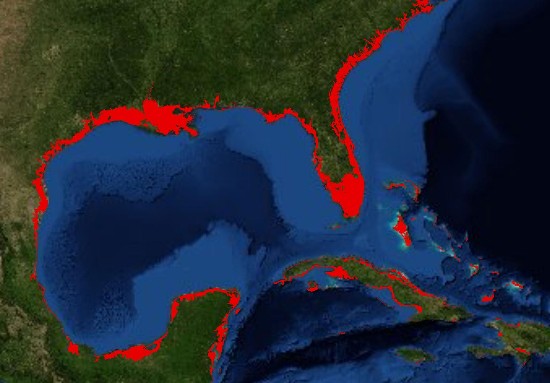Two studies of a warming Gulf of Mexico have been published in the last few weeks, the first online in the Journal of Climate, and the second today in Nature Communications. Both are raising the alarm with scientists studying the ocean and climate change. Both studies indicate rapid sea level rise along the entire U.S. Gulf Coast with increased flood risk to coastal communities and infrastructure.
“Sea-level rise is one of the most severe consequences of a warming climate, threatening hundreds of millions of people living in low-lying coastal communities” state the authors of the Nature Communications article.
To what is it attributable? And just how bad is it?
It is described as an “unprecedented” rise not seen in 3,000 years with the cause – ocean thermal expansion.
What is ocean thermal expansion? It is a natural phenomenon that occurs when water is heated. Thermal expansion has been tracked since sea level readings were first recorded. Between 1900 and 2021, the warming ocean has seen a variable rise between 1.7 millimetres (0.07 inches) and 8.4 millimetres (a third of an inch) per year. Since 2006, sea levels have accelerated in their annual rise amounting to a 20-centimetre (8-inch) increase within that short period.
And unlike Las Vegas, what happens in the Gulf doesn’t stay in the Gulf. That’s because the Gulf Stream which runs along the entirety of the U.S. eastern seaboard from the Florida Keys to North Carolina (the area where the ocean warming is most notable) brings its heat into much of the North Atlantic Ocean feeding a conveyor belt that reaches the shores of Western Europe. Some scientists believed this increased Gulf warmth is contributing to a slowing down of the conveyor belt known as the Atlantic Circulatory Current. They also attribute the increase in more powerful hurricanes to the warming Gulf and Atlantic.
Gulf and Ocean aren’t confined to the surface. The Journal of Climate paper notes that 80 to 90% of the heat can be found in the water column extending to depths of 1,000 metres (3,300 feet). The balance reaches depths of 2,000 metres (6,600 feet). This range of warming impacts the Atlantic conveyor belt because of its below-surface loop which brings cooler water from the poles down south. That in turn means the warmer water can displace the cold with likely impacts on the Arctic’s climate, and Greenland’s ice sheets.
Sönke Dangendorf of Tulane University who is one of the authors of the Nature Communications study, calls the rise “unprecedented in at least 120 years” and “a window into the future.”
Where are America’s coastlines most vulnerable: from Pensacola, Florida, to Galveston, Texas. And from Georgia’s barrier islands to Cape Hatteras in North Carolina.
But what has researchers flipping out is the short window of change in sea level rise. Used to dealing with data collected over many decades, it is hard to contextualize data that is less than twenty years in total. In an article appearing in today’s Washington Post that highlights the two studies, authors Chris Mooney and Brady Dennis state that the recent trend is “ambiguous” and “worrying.” Dangendorf uses the word “troubling.” One thing is very clear, the greenhouse gasses we continue to pump into the atmosphere heat it which then heats the ocean. This is us messing up the planet in pursuit of a 21st-century tech-heavy lifestyle. Meanwhile more people in the United States are moving to Florida and its sunshine coasts where all the warning signs point to a coming disaster, sooner than later.
Sea level records from Pensacola and Galveston date back more than a century. It should be noted that during that time, sea levels in the Gulf have risen and fallen. But based on the rate of accelerated rise, there is nothing in the historical record to match the current trend which should exceed even the highest levels ever seen.

















ROFL!!!
Please explain how the ocean rises in the Gulf of Mexico, but not over the entire ocean? After laughing at that, I just couldn’t finish the attic because it’s not worth taking seriously.
Have you considered beach and land erosion?
Dear E.K., The ocean does not have a uniform sea level height across the planet. Physical geography dictates this as do the gravitational forces that pull and push ocean water around the planet. Thermal expansion increases the volume of warm ocean water. So the Gulf of Mexico, which experiences higher rates of warming than the North Atlantic tends to be higher at its sea level than the neighbouring Caribbean Sea or Atlantic Ocean. And I am sure I don’t need to point out that the ocean is dynamic with tides raising and lowering sea level daily.